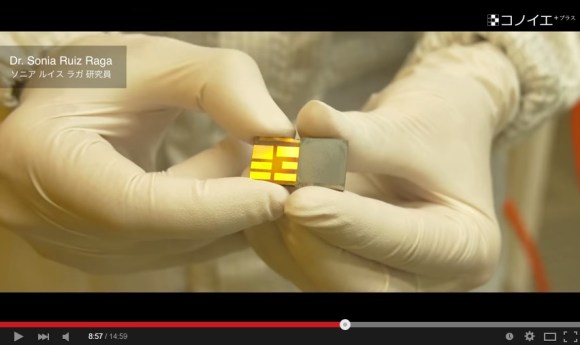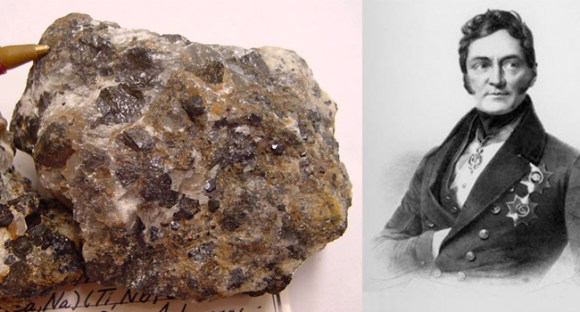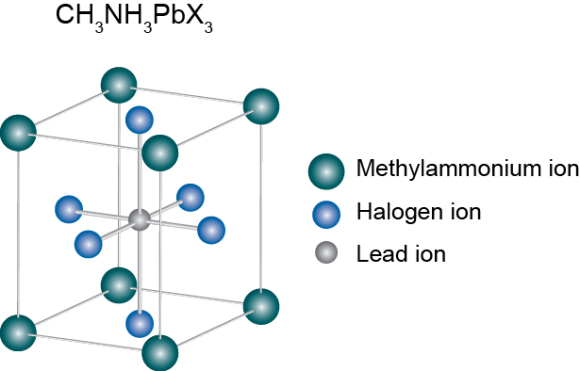
Back in 2009, a research team from the University of Tokyo led by Professor Tsutomu Miyasaka found that a substance called perovskite had the potential to generate solar power. However, at the time it only had a very weak power conversion efficiency (PCE) of about four percent and would break down in just a few minutes.
Because of these sizable flaws, not could practical use could be made of perovskite and the discovery lay dormant for a few years. Then, after a Korean team managed to double the PCE in 2011, research into the material was reignited. Now as scientists around the world continue to work on it, the PCE has become well above 20 percent and comparable with the standard silicon-based solar panels that we see today.
With perovskite being drastically cheaper to produce, more flexible to use, and now as efficient as regular solar panels, could we be on the verge of a solar energy revolution?
■ What is perovskite?
Perovskite is not a new material at all. It was discovered back in 1839 in Russia by German mineralogist Gustav Rose and was named after his Russian colleague Lev Perovski, for some reason.
▼ Come to think of it, there is a bit of a resemblance
This perovskite was a compound of calcium and titanium, but nowadays the name perovskite applies to any compound which has the same crystal structure. In the case of producing solar energy the perovskite is generally made up of organic and inorganic substances. For example methylammonium lead trihalide is a popular compound…perhaps because of its catchy name.
Solar panels that you see now are produced with silicon. Silicon is easy enough to find which keeps the cost reasonable, but it still ends up skyrocketing once manufacturing comes into play which involves vacuums and extremely high temperatures. Synthesizing perovskite, however, only requires the kind of temperatures you can achieve in your kitchen.
■ The Good
While perovskite is much cheaper to produce than current solar power generating materials, there are yet more benefits to it. Since it is produced chemically it can be made into a liquid substance which can then be painted onto a surface and left to dry.
For example, if you were driving an electric car, the car’s entire body could act as a charger. And don’t let the dealer try to overcharge you for that feature because you know perovskite is cheap. Japanese tech website Futurus says that one square meter (11 square feet) painted with power-producing perovskite would run you about 150 yen (US$1.25).
Dr. Sonia Ruiz Raga at the Okinawa Institute of Science and Technology mentions more benefits in the video, but be forewarned: it’s a long one, complete with mood-establishing shots of slow-motion walking.
In the video Dr. Raga points out that this new material can go in parts of the house where current solar panels cannot. For example, traditional homeowners with ornamental roofs can retain that style and still produce power. Because the substance is translucent it could also be used on windows. In theory, you could even paint a PC with it, sit it in a sunny corner of the house, and have it run solely on its own generated power.
■ The bad and the ugly
One of the biggest challenges of making perovskite practical and profitable is in the efficiency (the ratio of “power out” over “power in”). Although, reports of over 20 percent have been achieved, they were done so in controlled lab conditions. Chances are, once you start painting every nook and cranny of your house in mass-produced perovskite results may vary.
Secondly, remember when I said Prof. Miyasaka’s perovskite solar cell back in 2009 only lasted a few minutes? Well, improvements have been made in this area so that now according to Dr. Raga a coat of perovskite paint would last a week or so. Considering how cheap it is, that might not be a deal-breaker. However, having to slap on a coat of power-producing paint every fortnight doesn’t really seem like the wave of the future either.
Depending on your attitude, these aren’t flaws as much as just challenges that need to be overcome. Dr. Raga predicts that is the global community of researchers put enough effort into it, perovskite will be a force to be reckoned with in about five years’ time. Meanwhile, Futurus quotes Prof. Miyasaka as saying that a prototype perovskite system for practical use will be completed this year.
It’s still a way away, but the day may come where by tinting our windows with perovskite we can not only charge our cars but keep the inside upholstery from becoming a brazier on summer days. Now, that’s a future I can get behind!
Source: Futurus via Itai News (Japanese)
Video: YouTube – Purasukonoie
Images: Wikipedia – Andrew Silver, Friedrich Jentzen, Sevhab,



 Ramen restaurant’s English menu prices are nearly double its Japanese ones, denies discriminating
Ramen restaurant’s English menu prices are nearly double its Japanese ones, denies discriminating Here’s what our bachelor writers ate over the New Year’s holiday in Japan
Here’s what our bachelor writers ate over the New Year’s holiday in Japan 7 great places to see Mt. Fuji from without having to climb it
7 great places to see Mt. Fuji from without having to climb it 20 Guilt Free Snacks With Only A Hundred Calories
20 Guilt Free Snacks With Only A Hundred Calories Adorable AND delicious — Miffy Toast is the latest Japanese TikTok trend【SoraKitchen】
Adorable AND delicious — Miffy Toast is the latest Japanese TikTok trend【SoraKitchen】 Ramen restaurant’s English menu prices are nearly double its Japanese ones, denies discriminating
Ramen restaurant’s English menu prices are nearly double its Japanese ones, denies discriminating Here’s what our bachelor writers ate over the New Year’s holiday in Japan
Here’s what our bachelor writers ate over the New Year’s holiday in Japan 7 great places to see Mt. Fuji from without having to climb it
7 great places to see Mt. Fuji from without having to climb it 20 Guilt Free Snacks With Only A Hundred Calories
20 Guilt Free Snacks With Only A Hundred Calories Adorable AND delicious — Miffy Toast is the latest Japanese TikTok trend【SoraKitchen】
Adorable AND delicious — Miffy Toast is the latest Japanese TikTok trend【SoraKitchen】 Nearly one in ten young adults living in Japan isn’t ethnically Japanese, statistics show
Nearly one in ten young adults living in Japan isn’t ethnically Japanese, statistics show Studio Ghibli releases new “Butterflies in the Forest” Totoro towels
Studio Ghibli releases new “Butterflies in the Forest” Totoro towels Starbucks releases a Kyoto Matcha Latte in Japan for a limited time
Starbucks releases a Kyoto Matcha Latte in Japan for a limited time New York Asian Film Fest to screen Hentai Kamen 2
New York Asian Film Fest to screen Hentai Kamen 2 What do Japanese People Put in Their Rice Balls? Top 22 Most Popular Onigiri Fillings!
What do Japanese People Put in Their Rice Balls? Top 22 Most Popular Onigiri Fillings! Japanese beef bowl chain Sukiya’s 2026 Smile Box lucky bag basically pays for itself
Japanese beef bowl chain Sukiya’s 2026 Smile Box lucky bag basically pays for itself Starbucks Japan ready to get Year of the Horse started with adorable drinkware and plushies【Pics】
Starbucks Japan ready to get Year of the Horse started with adorable drinkware and plushies【Pics】 Hayao Miyazaki says Happy New Year to Studio Ghibli fans with new art for Year of the Horse
Hayao Miyazaki says Happy New Year to Studio Ghibli fans with new art for Year of the Horse Cup Noodle tries an authentic Jiro-style ramen, but something’s not quite right
Cup Noodle tries an authentic Jiro-style ramen, but something’s not quite right Top Japanese cosplayer Enako returns to Comiket after 6 years, creates mayhem with admirers
Top Japanese cosplayer Enako returns to Comiket after 6 years, creates mayhem with admirers The best Starbucks Japan Frappuccinos we want to drink again in 2026
The best Starbucks Japan Frappuccinos we want to drink again in 2026 We revisited Sweets Paradise after a decade to see if Japan’s dessert buffet still delivers
We revisited Sweets Paradise after a decade to see if Japan’s dessert buffet still delivers That time Seiji called JASRAC to ask why he didn’t get paid royalties for his song being on TV
That time Seiji called JASRAC to ask why he didn’t get paid royalties for his song being on TV Pizza Hut Japan’s hot lucky bags are perfect for a New Year’s pizza party
Pizza Hut Japan’s hot lucky bags are perfect for a New Year’s pizza party Majority of Japanese mayors say foreign residents are essential but most see good and bad effects
Majority of Japanese mayors say foreign residents are essential but most see good and bad effects 7-Eleven Japan starts new temporary luggage storage service in over 300 branches
7-Eleven Japan starts new temporary luggage storage service in over 300 branches Disillusionment at Tsukiji’s tourist-target prices led us to a great ramen restaurant in Tokyo
Disillusionment at Tsukiji’s tourist-target prices led us to a great ramen restaurant in Tokyo Starbucks teams up with 166-year-old Kyoto doll maker for Year of the Horse decorations【Photos】
Starbucks teams up with 166-year-old Kyoto doll maker for Year of the Horse decorations【Photos】 Tokyo considering law requiring more trash cans following litter increase in heavily touristed area
Tokyo considering law requiring more trash cans following litter increase in heavily touristed area Tokyo’s Tsukiji sushi neighborhood asks tour groups to stay away for the rest of the month
Tokyo’s Tsukiji sushi neighborhood asks tour groups to stay away for the rest of the month Tokyo event lets you travel back in time, for free, to celebrate 100 years since Showa era start
Tokyo event lets you travel back in time, for free, to celebrate 100 years since Showa era start Japan may add Japanese language proficiency, lifestyle classes to permanent foreign resident requirements
Japan may add Japanese language proficiency, lifestyle classes to permanent foreign resident requirements Sanrio theme park in Japan announces plans to expand into a Sanrio resort
Sanrio theme park in Japan announces plans to expand into a Sanrio resort Lacquerware supplier to emperor of Japan and Pokémon team up for new tableware
Lacquerware supplier to emperor of Japan and Pokémon team up for new tableware Survey asks foreign tourists what bothered them in Japan, more than half gave same answer
Survey asks foreign tourists what bothered them in Japan, more than half gave same answer Japan’s human washing machines will go on sale to general public, demos to be held in Tokyo
Japan’s human washing machines will go on sale to general public, demos to be held in Tokyo Japan’s deadliest food claims more victims, but why do people keep eating it for New Year’s?
Japan’s deadliest food claims more victims, but why do people keep eating it for New Year’s? We deeply regret going into this tunnel on our walk in the mountains of Japan
We deeply regret going into this tunnel on our walk in the mountains of Japan Studio Ghibli releases Kodama forest spirits from Princess Mononoke to light up your home
Studio Ghibli releases Kodama forest spirits from Princess Mononoke to light up your home Major Japanese hotel chain says reservations via overseas booking sites may not be valid
Major Japanese hotel chain says reservations via overseas booking sites may not be valid Put sesame oil in your coffee? Japanese maker says it’s the best way to start your day【Taste test】
Put sesame oil in your coffee? Japanese maker says it’s the best way to start your day【Taste test】 No more using real katana for tourism activities, Japan’s National Police Agency says
No more using real katana for tourism activities, Japan’s National Police Agency says Starbucks Japan reveals new sakura drinkware collection, inspired by evening cherry blossoms
Starbucks Japan reveals new sakura drinkware collection, inspired by evening cherry blossoms Updated cherry blossom forecast shows extra-long sakura season for Japan this year
Updated cherry blossom forecast shows extra-long sakura season for Japan this year Nearly one in ten young adults living in Japan isn’t ethnically Japanese, statistics show
Nearly one in ten young adults living in Japan isn’t ethnically Japanese, statistics show Studio Ghibli releases new “Butterflies in the Forest” Totoro towels
Studio Ghibli releases new “Butterflies in the Forest” Totoro towels Starbucks releases a Kyoto Matcha Latte in Japan for a limited time
Starbucks releases a Kyoto Matcha Latte in Japan for a limited time New York Asian Film Fest to screen Hentai Kamen 2
New York Asian Film Fest to screen Hentai Kamen 2 What do Japanese People Put in Their Rice Balls? Top 22 Most Popular Onigiri Fillings!
What do Japanese People Put in Their Rice Balls? Top 22 Most Popular Onigiri Fillings! 7 reasons why you should visit Aomori Prefecture
7 reasons why you should visit Aomori Prefecture Japanese beef bowl chain Sukiya’s 2026 Smile Box lucky bag basically pays for itself
Japanese beef bowl chain Sukiya’s 2026 Smile Box lucky bag basically pays for itself Rakuten randomly offers 58 New Year’s osechi feasts in Japan, but did we get a star or a dud?
Rakuten randomly offers 58 New Year’s osechi feasts in Japan, but did we get a star or a dud? W.T.F. Japan: Top 5 kanji with ironic meanings【Weird Top Five】
W.T.F. Japan: Top 5 kanji with ironic meanings【Weird Top Five】 Chic samurai coats from Japan are here to keep fashion warriors warm through the winter
Chic samurai coats from Japan are here to keep fashion warriors warm through the winter We almost cried on our first visit to this under-the-radar budget Italian restaurant in Japan
We almost cried on our first visit to this under-the-radar budget Italian restaurant in Japan Tokyo bento boxed lunch shop charges different prices depending on how heavy your laptop is
Tokyo bento boxed lunch shop charges different prices depending on how heavy your laptop is Studio Ghibli stamps lift your spirits with motivational phrases from Totoro
Studio Ghibli stamps lift your spirits with motivational phrases from Totoro We Lose All Sense of Time and Space in the Magical and Beautiful Lello & Irmão Bookstore
We Lose All Sense of Time and Space in the Magical and Beautiful Lello & Irmão Bookstore
Leave a Reply